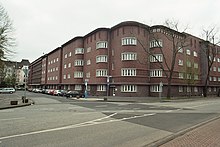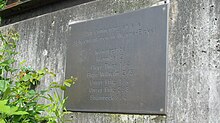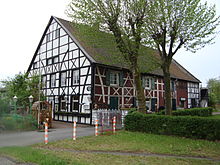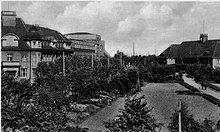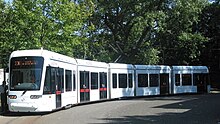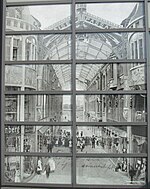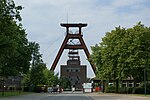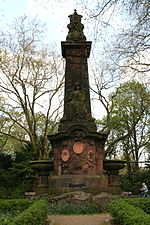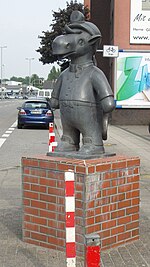Wanne-Eickel
|
Wanne-Eickel
City of Herne
|
|
|---|---|
| Coordinates: 51 ° 31 ′ 57 " N , 7 ° 9 ′ 42" E | |
| Height : | 60 m |
| Area : | 21.31 km² |
| Incorporation : | 1st January 1975 |
| Postal code : | 44649, 44651, 44652, 44653 |
| Area code : | 02325 |
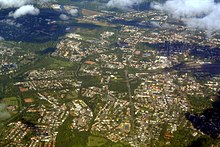

Wanne-Eickel was an independent city in the northern Ruhr area that existed from 1926 to 1974. As part of the NRW regional reform , it was merged with the independent city of Herne with effect from January 1, 1975 . Wanne-Eickel was granted district freedom in 1926 as an urban district, from 1955 to 1970 it was a major city . Until the merger with Herne, Wanne-Eickel had the greatest statistical population density of all German cities; on an area of 21.31 km² this was about 5,100 inhabitants per km² in December 1965.
The coat of arms of the town of Wanne-Eickel was changed slightly to that of the new town of Herne. The city colors gold-black-gold were also adopted. The old WAN license plate can be reassigned since December 2012 in connection with license plate liberalization .
The development of Wanne-Eickel was closely linked to mining, which had a decisive influence on growth. A total of 20 pits from the Königsgrube , Hannibal , Pluto Thies / Pluto Wilhelm , Unser Fritz and Shamrock collieries were distributed across the former urban area . Coal mining lasted from 1856 to 1993, and several industrial monuments remember this time.
history
The part of the later twin town that was more important in the Middle Ages was the Eickel to the south, first mentioned as Eclo in the early Middle Ages . At the beginning of the 14th century the first church was mentioned in the village. The largest settlement in the northern part of what would later become the city was called Bickern . Another historic district is Crange , which was raised to a freedom in 1484 and was allowed to hold a horse market. The Cranger Kirmes , which is also known nationwide, developed from this market . These three places were 1 August 1875 inclusion of places Holsworthy and Röhlinghausen for Office tub in district Bochum combined. Before that, the places mentioned belonged to the Herne Office .
The name Wanne for the new office is an old field name in a depression, which, however, is documented as villa Wanomhana as a subordinate of Bickern as early as the 9th century . The name was a compromise solution on the occasion of the naming of the common station on the Cologne-Minden Railway, which opened in 1847 . This station developed into the largest marshalling yard in the central Ruhr area , which, by the way, was the only one in the Ruhr area to combine all four modes of operation: In addition to the aforementioned function as a marshalling yard, it was also the home station for over 300 locomotives and traction vehicles, freight yard and passenger station. As the main train station, it still has important traffic significance as the intersection of the east-west connection Dortmund - Oberhausen with the north-south connection Münster - Essen .
With the rapid industrialization in the second half of the 19th century , the settlements grew considerably. In 1885 the Wanne office came to the new district of Gelsenkirchen , and in 1897 the Bickern municipality took over the name "Wanne" from its office. In 1891 the Wanne office was divided, the new Eickel office was created with the communities of Eickel and Holsterhausen. The municipalities of Wanne (formerly Bickern), Crange and Röhlinghausen remained in the Wanne office. In 1905 Crange was incorporated into Wanne and in 1910 Holsterhausen was incorporated into Eickel . The Eickel office then consisted of only one municipality, while the Wanne office still included the Röhlinghausen municipality.
On April 1, 1926, the two offices tub and Eickel became the independent city Wanne-Eickel combined . During the Second World War , Wanne-Eickel was badly damaged by Allied bombing attacks - on the one hand because of its large train station, which formed a hub for supplies to the western front , and on the other because of the production of synthetic gasoline in the "fuel works" in Eickel. After the Second World War, the population rose sharply, so that Wanne-Eickel rose to become a major city in 1955 . Wanne-Eickel did not even exist as an independent town for 50 years. In order to avoid the threat of incorporation into Bochum as part of a municipal reform, the council of Wanne-Eickel decided to merge with the neighboring town of Herne, which was roughly the same size. The legislature followed this wish and so on January 1, 1975 the new city of Herne was created, in which four new city districts were formed. This resulted in the formation of the current city districts of Wanne and Eickel. In the former urban area of Wanne-Eickels, the name “Wanne-Eickel” is still used today, but it is still known throughout the region. The German Bahn AG has the name " Wanne-Eickel Hbf maintained". In 2003, Deutsche Bahn planned to rename it to Herne-Wanne or Herne Hauptbahnhof. However, these considerations met with great resistance in Wanne-Eickel, so that the local politicians in Herne also dealt with them.
Economy and Infrastructure
Companies
In addition to mining, the most important branch of the city for a long time, bread production played an important role in Wanne-Eickel's economic history. The bakers 'and confectioners' guild of the two offices of Wanne and Eickel already had so many members in 1907 that they formed their own health insurance fund. Before the Second World War, Wanne-Eickel occupied fourth place in bread production in Germany based on the size of the population. At that time, Wanne-Eickel was actually referred to as the city of bread .
Another well-known branch of industry was the beer production of the Eickel Pils by the Hülsmann brewery. This closed in 1992; The Hülsmann pub is now located in the building of the former brewery, as well as several administrative offices of the city of Herne in the former brewery and brewhouse .
traffic
In the city of Wanne-Eickel there are the following important transport connections:
Railways
The freight traffic, which is important for Wanne-Eickel, is handled on Deutsche Bahn , Wanne-Herner Eisenbahn and RBH Logistics routes . The last two mainly connect the industrial companies, such as the freight traffic center in Wanner Westhafen, Evonik Industries and the coal mixing plant of DSK at Wanne-Eickel main station.
For the routes in the Wanne-Eickel area, see Wanne-Eickel Hbf . In the city there were formerly four stops or train stations , of which only
- Wanne-Eickel Hbf
has been preserved as a passenger train station.
- The Röhlinghausen stop on the salt line between Bochum-Riemke and Wanne-Eickel has been in operation since 1893. The station building was not rebuilt after being destroyed in World War II. In 1950 the breakpoint was renamed Wanne-Röhlinghausen . Passenger train traffic was discontinued in 1960 with the closure of the Königsgrube colliery .
- The Hordel-Eickel stop between Bochum-Riemke and Wanne-Eickel was put into operation in 1886. The first station building had formerly been in Oberhausen and, after Eickel translocated . Due to subsidence, the railway line was lifted and the old station building was replaced by a modern building. In 1950 the breakpoint was renamed Wanne-Eickel Süd . The passenger train service was stopped in 1960.
- Our Fritz stop between Wanne-Eickel and Gelsenkirchen-Bismarck was put into operation in 1891. The station was named Wanne-Unser Fritz in 1914 . Operation in passenger traffic was given up in 1983.
tram
Today there is only one tram line left, line 306 of Bochum-Gelsenkirchener Straßenbahnen AG (BOGESTRA), which connects the main stations of Wanne-Eickel and Bochum . Until the 1950s, line 4 of the BOGESTRA ran from the main station via Gelsenkirchen to Essen-Steele and line 1 of the Vestischen from the main station to Herten.
Streets and squares
As early as the 17th century there were carters in the Bochum office who took over the transport of coal from the mining areas of the county of Mark to the Lippe or to the Rhine. As the plans to make the Emscher navigable failed, the Gahlener Kohlenweg was laid out in 1763 . From Bochum-Hamme via Eickel, Holsterhausen, Crange and Unser Fritz on to Gelsenkirchen-Bismarck, this trade route crossed the Wanne-Eickel area over a length of about 8 km. Some structures, some of which still exist today, were erected along the route. On the border to Bochum is the former restaurant " Löns Mühle ", on whose meadows there was a racecourse; In the middle of the trade route is the former " Schlenkhoffsche Kotten ", the restaurant Zum alten Fritz ; on the border to Gelsenkirchen there is the Fleuthebrücke . The course of Reichsstraße 226, built in 1937 and today's B 226, is almost identical to the Kohlenweg in Wanne-Eickel. Today's main street, the Communicationsweg in the Eickel community atlas from 1923, can already be seen on the map from 1842. A part of Wanner was called the "Renne".
Highways
The A 42 was completed in the Wanne-Eickel area between the Herne Baukau (22) and Gelsenkirchen-Bismarck (18) junctions between 1968 and 1971. Initially released as a state road , it was upgraded to a motorway as part of the construction work. The Herne-Wanne (19), Herne-Crange (20) junction and the Herne motorway junction (21) are located in the Wanne-Eickeler area .
The Reichsstraße 51, which was introduced in 1934 and later the B 51 , was expanded in the Wanne-Eickel area in 1967 to the A 43 between the Recklinghausen-Hochlarmark (13) and Bochum-Riemke (16) junctions. From the city limits of Bochum to about the crossing under the Cranger Straße it forms the border to Herne. The Herne-Eickel junction (15) and the Herne motorway junction (14) are located in the Wanne-Eickel area .
The Herten (7) junction of the A 2 and Bochum-Hamme (33) junction of the A 40 indicate on their departure signs to districts of Wanne-Eickel, but the junctions are approx. 2 km from the city limits. The motorways do not cross the Wanne-Eickel area.
Rhine-Herne Canal
The Emscher flowed in Wanne-Eickel meandering through a former meadow landscape. With the mining and the associated subsidence and pollution of the river, the river was straightened from the late 19th century, put in a concrete channel and moved up to 600 m to the north in the entire area of Wanne-Eickel. From 1906 to 1914, the "Royal Canal Construction Directorate" built the Rhine-Herne Canal on the former Emscher river bed. In this context, the Wanne-Eickel lock was built with a fall height of 8.40 m. The canal and lock have been partially expanded over the years to accommodate the larger ships. The Westhafen, where large quantities of bulk goods such as coal and sand were still being loaded during the mining era, was later backfilled. The bulk goods are loaded today at the quay wall of the canal. A modern freight transport center has been built on the filled harbor basin. The east port is used for the loading of scrap. Both ports and the freight center are operated by the Wanne-Herner Eisenbahn und Hafen .
Population development
In 1926 the municipalities of Wanne (40,000 inhabitants), Eickel (35,000 inhabitants) and Röhlinghausen (15,000 inhabitants) merged to form the town of Wanne-Eickel with around 90,000 inhabitants. In 1955, the city's population exceeded 100,000, making it a major city . In 1965 the population of Wanne-Eickel reached its historical high of around 110,000 (the city had more inhabitants than Herne at that time). Since then the number of inhabitants has decreased again. Wanne-Eickel remained a big city until the beginning of 1970. By 2001 the number had dropped to 80,218 inhabitants.
The following overview shows the number of inhabitants according to the respective territorial status. Up to 1833 these are mostly estimates, then census results (¹) or official updates by the respective statistical offices or the city administration itself. From 1843 onwards, the information relates to the “local population” and from 1925 to the resident population . Before 1843, the number of inhabitants was determined according to inconsistent survey methods.
|
|
¹ census result
politics
At the beginning of the 19th century, the community leaders and community representatives were at the head of the communities that later belonged to the city of Wanne-Eickel. After the offices of Wanne and Eickel had been formed, officials headed the administration. A city council was not elected until the city of Wanne-Eickel was formed in 1926. The head of the city was then the mayor, who was appointed by the NSDAP during the National Socialist era .
After the Second World War, the military government of the British occupation zone appointed a new Lord Mayor and in 1946 it introduced the local constitution based on the British model. Then there was a popularly elected “City Council”, whose members were called “City Councilors”. The council initially elected the mayor from among its members as chairman and representative of the city, who was active on a voluntary basis. Furthermore, from 1946 the council also elected a full-time senior city director as head of the city administration. This system existed until it was united with the city of Herne in 1975.
→ See also: Results of the local elections in Wanne-Eickel
Lord Mayor
- 1926: Friedrich Weiberg ( DVP ) (acting mayor)
- 1926–1933: Wilhelm Kiwit ( center ) (Mayor from 1929)
- 1933–1934: Wilhelm Wulf ( NSDAP ) (acting)
- 1934–1945: Heinrich Günnewig (NSDAP)
- 1945: Karl Neuhaus ( CDU )
- 1945–1946: Wilhelm Jacobi ( SPD )
- 1946: Wilhelm Heimüller ( KPD )
- 1946–1948: Heinrich Weidmann (CDU)
- 1948–1969: Edmund Weber (SPD)
- 1969–1974: Manfred Urbanski (SPD)
Senior City Directors
- 1946–1947: Wilhelm Jacobi (SPD)
- 1947–1959: Wilhelm Elbers (independent)
- 1960–1974: Alfred Hufeld (independent)
Attractions
- Christ Church
- Cranger fun fair
- Fritzchen at Cranger Tor, mascot of the fair
- Three-men-corner by Wilhelm Braun
- Emscher horse
- Erzbahn cycle path
- Headframe of the Pluto Wilhelm colliery by Fritz Schupp (1953)
- House Crange
- Wanne-Eickel Local History and Natural History Museum
- Artist mine
- Hotel-restaurant "Cranger Hof" with baroque interior
- Ev. Johanneskirche (1896)
- Jewish Cemetery
- Imperial Hall
- Catholic parish church St. Josef ("Löwenkirche") (1909)
- Catholic Parish Church St. Laurentius (1884–1886 / 92)
- Ev. Luther Church (1907)
- Peace Church (1966) of the local Evangelical Free Church Community
- Malakow tower of the Unser Fritz colliery (shaft 1)
- Mondpalast , the former hall building (1911)
- Mozartstrasse, the former Kaiserpassage (1905–1910)
- Main Post Office (1912–1914)
- Town hall (1903–1904), until 1926 the office building of the Wanne office
- Hannover Settlement (1864–1928)
- Wilhelmsquelle brine and thermal baths (1921)
- Sparkasse with adjoining housing development at Roter Block (1926–1928)
- City garden with Kaiserbrunnen (1898–1901)
- Herne forest cemetery
- Wanne-Eickel Central Station (1913)
Personalities
sons and daughters of the town
- * 1845, February 19 (in Crange ), Friedrich Brockhoff , educator and musician († March 8, 1926 in Wanne)
- * 1858, March 19 (in Eickel), Wilhelm Middeldorf , hydraulic engineer, pioneer of Emscher regulation († August 24, 1911 in Essen)
- * 1865, June 26th (in Wanne), Paul Hein , businessman, mine general manager († 1945)
- * 1878, March 13th (in Eickel), Hermann Schultz , administrative lawyer, district administrator of the Tecklenburg district († 1953 in Osnabrück)
- * 1881, October 5, Wilhelm Meisner , ophthalmologist and university professor († January 2, 1956 in Munich)
- * 1887, November 23 (in Eickel), Heinrich Pette , doctor and neurologist († October 2, 1964 in Meran)
- * 1896, May 1 (in Bickern ), Herbert FW Tengelmann , lawyer, businessman and industrialist († February 22, 1959)
- * 1898, September 9, August Stötzel , miner, communist resistance fighter against National Socialism, prisoner in Buchenwald concentration camp and party functionary (KPD / SED) († August 17, 1963 in East Berlin)
- * 1898, October 14, Friedrich Welskop (in Eickel or Wanne), lawyer and politician (CDU), Member of the Bundestag, City Councilor in Castrop-Rauxel († October 20, 1977 in Castrop-Rauxel)
- * 1901, January 29 (in Eickel), Karl-Friedrich Dörnemann , politician (NSDAP), MdL († after 1966)
- * 1901, July 18, Joachim Beckmann , Protestant theologian and President of the Evangelical Church in the Rhineland (1958–1971) († January 19, 1987 in Haan)
- * 1901, July 18 (in Holsterhausen), Stanisław Mikołajczyk , Polish Prime Minister in exile († December 13, 1966 in Washington, DC)
- * 1902, May 30, Heinrich Demand , politician (SPD) († April 16, 1974)
- * 1902, September 27, Arthur Jopp , actor († April 1, 1990 in East Berlin)
- * 1902, November 15 (in Eickel), Otto Neuloh , sociologist and ergonomist († April 7, 1993 in Baden-Baden)
- * 1903, March 13, Willi Heitkamp , member of the state parliament, born in Wanne-Röhlinghausen († November 16, 1988)
- * 1904, July 11th (in Eickel or Wanne), Ernst Schütte , politician (SPD), MdL († October 24th 1972 near Antalya)
- * 1904, October 9 (in Röhlinghausen), Erich Püschel , physician and founder of the medical history collection at the Ruhr University Bochum († June 24, 1991)
- * 1908, May 28, Karl Jansen , weightlifter, born in Eickel or Wanne († November 14, 1961)
- * 1909, March 11, Otto Walpert , politician (SPD) († March 11, 1979)
- * 1911, August 25, Wilhelm Iwanski , writer († February 1, 1985 in Iserlohn)
- * 1912, February 14th, Alfred Möhlenbruch , physician, born in Wanne-Eickel († February 17, 1973 in Hennef)
- * 1912, March 9, Werner Schäfer , virologist († April 25, 2000 in Tübingen)
- * 1913, August 12, Edmund Schuitz , artist († 1992 in Herne)
- * 1915, January 27, Ernst Schröder , actor and director († July 26, 1994 in Berlin)
- * 1916, January 5, Paul Marziniak , politician (SPD) († October 3, 1978)
- * 1916, August 14 (in Röhlinghausen), Rudolf Witzig , airborne engineer officer of the Wehrmacht († October 3, 2001 in Oberschleißheim)
- * 1917, May 16, Ulrich Matschoss , actor († July 1, 2013 in the Lüneburg Heath)
- * 1918, July 15, Theodor Hockerts , Professor of Pediatrics (†?)
- * 1919, May 19, Hermann Eppenhoff , soccer player (Schalke 04) and coach (Borussia Dortmund) († April 10, 1992 in Gelsenkirchen)
- * 1921, September 29 (in Eickel), Georg Ehrich , politician (CDU), Member of the Bundestag († April 14, 1985)
- * 1922, April 10, Hans-Eugen Schulze , judge at the Federal Court of Justice, born in Eickel († September 18, 2013 in Karlsruhe)
- * 1922, October 29, Rudolf Vierhaus , Professor, Director of the Max Planck Institute for History in Göttingen († November 13, 2011 in Berlin)
- * 1926, June 25, Günter Grandt , football player in the Oberliga West for Westfalia Herne († 1995)
- * 1926, June 26th, Heinrich Missalla , Catholic theologian, professor at the University of Essen († October 3, 2018)
- * 1926, July 4, Günter Korbmacher , lawyer and judge at the Federal Administrative Court († January 26, 2015 in Kleinmachnow)
- * 1927, June 14th, Erich Kuß , professor at the Ludwig Maximilians University in Munich
- * 1928, November 25, Günter Dworak , painter and graphic artist († May 12, 2000 in Herne-Wanne)
- * 1929, January 16, Werner Kowalski , professor at the Martin Luther University Halle-Wittenberg
- * 1929, October 5th, Ernst Zinn , architect, government building director and preservationist
- * 1931, July 27th, Walter Kiwit , senior district director of the Rhein-Sieg district
- * 1931, November 25, Werner Brenne , politician (SPD), Member of the Bundestag († July 28, 2010 in Brenne)
- * 1932, January 8th Heinz Kördell , football player
- * 1933, December 20, Helmut Hellwig , politician (SPD), city councilor of the city of Wanne-Eickel, MdL († June 7, 2016 in Herne)
- * 1934, January 17, Werner Krause , historian and archivist († June 30, 2014 in Bonn)
- * 1935, September 10th Kuno Gonschior , artist († March 16, 2010 in Bochum)
- * 1935, December 6th, Klaus Beckmann , musicologist, church musician and university professor
- * 1935, December 8, Karl Borutta , footballer († April 29, 2002 in Munich)
- * 1937, August 17, Udo Mlecek , engineer and head of the Central Telecommunications Office († June 1, 2012 in Hanover)
- * 1938, January 18, Wolfgang Becker , Lord Mayor of Herne
- * 1942, January 25, Klaus Fiedler , Protestant theologian, missiologist, mission historian and author
- * 1943, May 19, Heinz Lothar Grob , professor at the Westphalian Wilhelms University in Münster , developer of the VoFi
- * 1943, August 28th, Gerd Pieper , entrepreneur
- * 1945, February 6th, Heinz Stuy , former Dutch international and ex-goalkeeper of Ajax Amsterdam
- * 1947, December 18, Frank Sichau , state politician (SPD) in North Rhine-Westphalia
- * 1947, September 28, Gerd Bollmann , politician (SPD), Member of the Bundestag († September 16, 2017 in Herne)
- * 1948, August 4th, Klaus Aktories , physician and pharmacologist
- * 1949, January 6th, Josef Hackforth , German communication scientist
- * 1949, January 17th, Claus Matecki , trade unionist and member of the executive DGB federal board
- * 1949, March 3, Friedrich Gerhard Klimmek , crime novelist and lawyer
- * 1950, March 27th, Claus Leggewie , political scientist, head of the Cultural Studies Institute in Essen
- * 1951, July 28th, Peter Grzan , artist including the Künstlerzeche Unser Fritz († July 15, 2014)
- * 1952, June 26th, Wolfgang Quickels , photographer and journalist, († October 8th 2014 in Herne)
- * 1952, Bernd Willmes , Catholic theologian, priest and rector of the Fulda Theological Faculty
- * 1953, July 28th, Jürgen Bodeux , left-wing extremist
- * 1953, October 14th, Willi Thomczyk , actor (“ Die Camper ”), artist
- * 1954, January 26th, Wolfgang Berke , journalist and book author
- * 1954, November 5th, Josef Niebecker , army officer and defense attachee
- * 1955, October 2nd, Thomas Podella , Protestant theologian and ancient orientalist
- * 1955, Karl-Heinz Blomann , musician, composer and producer
- * 1955, March 4th, Ingo Marmulla , guitarist
- * 1955, October 29, Jürgen Grislawski , painter and sculptor
- * 1955, December 2nd, Achim Krämer , jazz drummer
- * 1956, June 17th, Horst Grabosch , musician in the field of jazz and new music
- * 1957, Gabriele Klein , sociologist, cultural and dance scholar
- * 1957, February 8th, Berthold Damshäuser , Malayologist and literary translator
- * 1957, June 25, Ingrid Fischbach , politician (CDU), Member of the Bundestag
- * 1958, July 22nd, Peter Nottmeier , actor (" Switch reloaded ")
- * 1958, September 26th, Rudi Cerne , figure skater, television presenter (" Aktenzeichen XY ... unsolved ")
- * 1958, November 14th, Eckard Koltermann , composer
- * 1959, Christian Eichler , sports journalist
- * 1959, Hartmut Kasper , writer (pseudonym: Wim Vandemaan)
- * 1960, January 10th, Claudia Losch , athlete
- * 1960, March 24th, Ralf Regenbogen , soccer player
- * 1961, Oliver Siebeck , actor and voice actor
- * 1962, Karin Polenz , artist
- * 1962, Der Telök , comedy duo
- * 1963, Jörg Uwe Sauer , writer and journalist
- * 1963, July 13th, Michael Rüter , former State Secretary in Lower Saxony
- * 1966, March 30th, Gregor Willmes , musicologist, music writer and cultural manager
- * 1966, December 16, Carsten Spohr , engineer and Chairman of the Board of Management of Deutsche Lufthansa AG
- * 1967, May 15, Andrea Jürgens , pop singer († July 20, 2017 in Recklinghausen)
- * 1967, May 24th, Guido Silberbach , soccer player and trainer.
- * 1967, November 16, Nicholas Bodeux , actor
- * 1968, June 27th, Thorsten Kinhöfer , soccer referee
- * 1968, September 6th, Michael Prange , chemist, archaeometallurge and materials scientist
- * 1972, May 15, Clarissa Knorr , actress and speaker
Personalities who have worked on site
- Friedrich Winter (born February 5, 1853 in Gehringhausen, † February 26, 1913 in Wanne), bailiff.
- Ernst Tengelmann (born January 14, 1870 in Somborn ; † March 30, 1954 in Essen ), German entrepreneur.
- Friedrich Weiberg (born February 16, 1870 in Westhofen , † December 16, 1946 in Bad Godesberg ), alderman and mayor.
- Karl Rüsewald (born May 30, 1880 in Neheim; † after 1940), from 1909 to 1940 senior teacher at the girls' high school in Wanne , 1932 and 1934 head.
- Wilhelm Braun (born October 7, 1880 in Uerdingen , † May 2, 1945 in Wanne-Eickel), sculptor and trade teacher.
- Wilhelm Jacobi (* 1881; † 1962), Lord Mayor and City Director.
- Wilhelmine Steltmann (born November 30, 1881 in Breckerfeld, † February 14, 1956 in Wanne), city councilor and headmistress
- Wilhelm Kiwit (born July 31, 1883 in Oberhausen; † December 7, 1959 in Münster), Lord Mayor.
- Gustav Sobottka (born July 12, 1886 in Turowe; † March 6, 1953 in Berlin), member of the Prussian state parliament (1921–1932):
- Heinrich Günnewig (born February 10, 1889 in Bochum, † August 7, 1981 in Düsseldorf), Lord Mayor.
- Franz Hruska (born November 21, 1888 in Dobrzan, Mies district, Bohemia; † April 29, 1977), politician (SPD), member of the Bundestag and Wanne-Eickel city councilor.
- Fred Endrikat (born June 7, 1890 in Nakel an der Netze , † August 12, 1942 in Munich ), writer and cabaret artist.
- Wilhelm Wulf (born December 27, 1892 in Monkowarsk, † October 17, 1960 in Essen), Deputy Mayor.
- Hans Mühle (born April 11, 1897 in Meinerdingen; † January 25, 1973 in Berlin), clergyman at the Johanneskirche (Eickel)
- Willi Henkelmann (born February 25, 1899 in Münster ; † July 2, 1928), European champion in motorcycle racing (175 cm³)
- Erich Meyer (born March 15, 1900 in Stettin; † May 9, 1968 in Wanne-Eickel), politician (Member of the Bundestag).
- Ludwig Steil (born October 29, 1900 in Lüttringhausen, † January 17, 1945 in Dachau), Protestant pastor in Holsterhausen, resistance fighter and martyr
- Heinz Rühmann (born March 7, 1902 in Essen, † October 3, 1994 in Berg am Starnberger See ), actor.
- Anton Graf (* 1905; † 1979), entrepreneur and founder of one of the largest coach companies in Germany.
- Walter Neusel (born November 25, 1907 in Bochum, † October 8, 1964 in Berlin), heavyweight boxer, The Blonde Tiger von der Dorneburg
- Friedrich Wilhelm Schwing (* 1909; † 1992), entrepreneur and founder of Schwing GmbH , the world's largest manufacturer of concrete pumps.
- Wilhelm Elbers (born April 27, 1913 in Wattenscheid; † unknown), City Director from 1947 to 1959.
- Fritz Panhorst (born October 25, 1915 in Berlin; † May 2, 1971), politician (CDU), Member of the Bundestag and mayor of Wanne-Eickel.
- Heinz Westphal (born June 4, 1924 in Berlin; † October 30, 1998 in Bonn), politician (SPD), Member of the Bundestag for the constituency of Wanne-Eickel - Wattenscheid.
- Elwin Schlebrowski (born August 31, 1925 in Klein-Kamionken; † February 8, 2000), miner, soccer player in Wanne-Eickel, at BVB 09 and national player.
- Bruno Unkhoff (born December 25, 1931 in Gelsenkirchen; † December 11, 2002 in Holzminden) sculptor.
- Rainer Schümann (born October 1, 1977), football player.
- Dustin Bomheuer (born April 17, 1991 in Recklinghausen), football player.
Cult for Wanne-Eickel
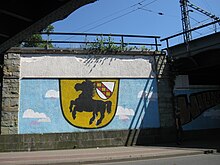
For those interested in local history, there are clubs that a. deal with local history.
The fan base around the city in the Ruhr area is growing increasingly, among other things because of the name and the symbolic meaning. This is how the city name falls in some amusing or ironic contexts:
- The moon by Wanne-Eickel , a song by Friedel Hensch and the Cyprys (1962).
- The liqueur "Mond von Wanne-Eickel" from the Eicker & Callen distillery
- The fictional character Adolf Tegtmeier of the comedian Jürgen von Manger comes from Wanne-Eickel.
- The fictional character Else Stratmann by the author and cabaret artist Elke Heidenreich comes from Wanne-Eickel, where she runs a butcher's shop with her husband Willi .
- The television film Auffrage zum Tanz (1977) with Marius Müller-Westernhagen was partly shot in Wanne-Eickel. a. the freight yard and the hotel "Alt Crange". In the better-known sequel Theo Against the Rest of the World (1980), Herne is where the main characters live.
- In the last stanza of Anne Kaffeekanne (1984), one of Fredrik Vahle's most famous children's songs , Wanne-Eickel is the end of a world tour.
- The Friday Night News presented a parody of the well-known CSI series with CSI: Wanne-Eickel .
- In the song Balu by the band Kettcar , the protagonist compares his situation with Wanne-Eickel. ("You are New York City and I am Wanne-Eickel.")
- In the song Frau ich freu mich from BAP it says "un dä Mond vun Wanne-Eickel ess no really nit dä Bringer!"
- The film Die Bademeister - women, drinking, saving lives with Michael Herbig (Bully) and Hilmi Sözer is also set in Wanne-Eickel, but here in the fictional district of “Cann”. The only scene in the film that actually has to do with Wanne-Eickel is the animation of a motorcycle ride, during which the main street in Wanne-Süd can be seen on a map.
- Feuer, Eis & Dosenbier (2002), with Axel Stein , Rick Kavanian and Eva Habermann in the leading roles, is about two Wanne-Eickel people doing community service.
- The Prince of Wanne-Eickel (2006), a film with u. a. Jürgen Drews .
- In his early sketch Reisebericht Norway, Hape Kerkeling draws the following comparison: “Amsterdam is the Venice of the north. Oslo, on the other hand, is Scandinavia's Wanne-Eickel: Nobody knows where it is, and nobody wants to go there. "
- In Hape Kerkeling's A Man, a Fjord , the main characters come from Wanne-Eickel.
- The internet satirical Stupidedia dedicates its own kingdom to Wanne-Eickel (VKWE = United Kingdom of Wanne-Eickel), which last appeared as the venue (and later winner) for the World Cup parody "Universe Championship 2010".
- The punk rock band Brigade S from Wanne-Eickel mentions this city in several songs and has dedicated its own to it.
- The series Hans im Glück from Herne 2 , broadcast in 1983 on ZDF, was mainly created in Wanne-Eickel.
- On February 28, 2012, the city council of Herne voted unanimously in favor of reintroducing the former WAN label. This is intended to strengthen the sense of tradition in Wanne-Eickel and the identification with the hometown. The aim is to “set an exclamation point”, for example by making greater use of the Wanne-Eickel brand. This means that all Herne residents - regardless of where they live within the city - can freely decide whether they want to have a HER or WAN license plate on their vehicle.
literature
- Erwin Roloff: Wanne-Eickel. Eine Stadt im Revier , Wanne-Eickel, 3rd edition 1971
- Heinrich Lührig, Gerhard Schmitz: Röhlinghausen Wanne-Eickel III. History and stories from a district in the southern Emscher region - listened to and experienced, collected and retold . BWF Verlag, Herne 1995, 2nd, expanded edition 1997
- Wolfgang Berke : The book on the city of Wanne-Eickel. Myths, cult, records: A journey through time through the heart of the Ruhr area , Essen, 5th edition 2007, ISBN 978-3-89861-122-0 ( digitized version )
- Wolfgang Berke: Wanne-Eickel - the second book on the city. Even more myths, cults and records: The journey through time continues , Essen 2005, ISBN 978-3-89861-447-4 ( digitized version )
Web links
- Herne.de: Coat of arms through the ages
- Wanne-Eickel Local History Society
- Historic Wanne-Eickel , private website
- Chronicle of Wanne-Eickel , private website
supporting documents
- ↑ Martin Bünermann, Heinz Köstering: The communities and districts after the municipal territorial reform in North Rhine-Westphalia . Deutscher Gemeindeverlag, Cologne 1975, ISBN 3-555-30092-X .
- ↑ derwesten.de: New old license plate WAN is tip in the Ruhr area from March 27, 2013, accessed on September 10, 2013
- ^ Erwin Roloff: Wanne-Eickel. A city in the district. Wanne-Eickel, 3rd edition. 1971, p. 9.
- ↑ Stephanie Reekers: The regional development of the districts and communities of Westphalia 1817-1967 . Aschendorff, Münster (Westphalia) 1977, ISBN 3-402-05875-8 .
- ^ Federal Statistical Office (ed.): Historical municipality directory for the Federal Republic of Germany. Name, border and key number changes in municipalities, counties and administrative districts from May 27, 1970 to December 31, 1982 . W. Kohlhammer, Stuttgart / Mainz 1983, ISBN 3-17-003263-1 , p. 329 .
- ↑ Berke: Das Buch zur Stadt (2007), pp. 30f.
- ↑ Wolfgang Berke: Hülsmann beer. Better a tub of Eickel than a glass of Dortmund. In: Wolfgang Berke: The book on the city of Wanne-Eickel. Myths, cults, records: a journey through time through the heart of the Ruhr area. Klartext-Verlag, 5th edition, Essen 2007, ISBN 978-3-89861-122-0 , pp. 66-67.
- ↑ Röhlinghausen train station on wanne-eickel-historie.de, accessed on January 2, 2014
- ↑ Hordel Eickel railway station on wanne-eickel-historie.de, accessed on January 2, 2014
- ^ City of Herne: Streets in Herne, Dorstener Straße , accessed on March 11, 2017
- ↑ The Eickeler Horse Racecourse - Löns Mühle , accessed on January 2, 2014
- ^ Herne - from Ackerstraße to Zur-Nieden-Straße. City history as reflected in the street names , edited by Manfred Hildebrandt, Ralf Frensel, Jeannette Bodeux and Franz Heiserholt (= publications of the Herne City Archives), Herne 1997.
- ^ Map from 1842 ( Memento from July 15, 2014 in the Internet Archive )
- ↑ Erich Kuss: Our Wanner Renne from around 1930 to around 1940: with northern and southern "outlet" , o. O. 2014 (digitized, PDF 1.4 MB).
- ↑ wanne-eickel.info: Willi Henkelmann: The forgotten European champion
- ^ Website Bruno Unkhoff ( Memento from July 18, 2011 in the Internet Archive )
- ↑ Bruno Unkhoff - the Bruno from the monopoly
- ↑ http://www.songtextemania.com/der_mond_von_wanne_-_eickel_songtext_friedel_hensch_and_die_cyprys.html
- ↑ 'Council of the City of Herne wants WAN license plate for Wanne-Eickel' . The west, news from Herne and Wanne-Eickel. Retrieved April 22, 2012.


